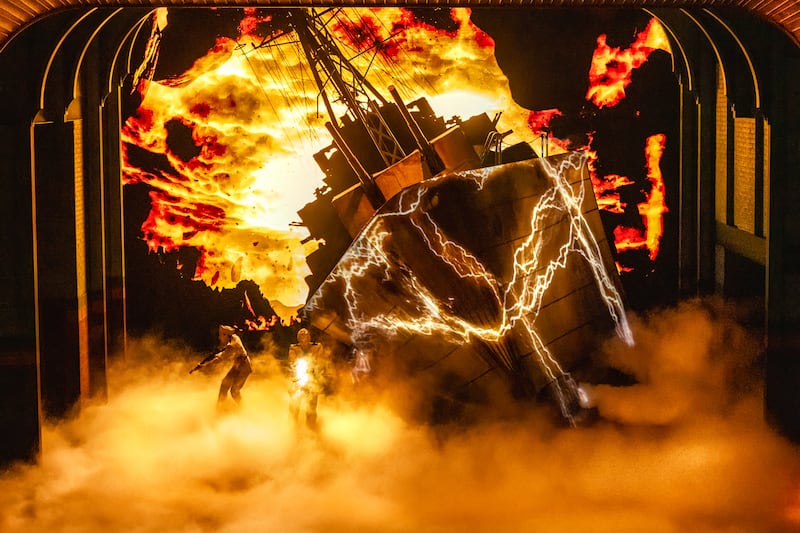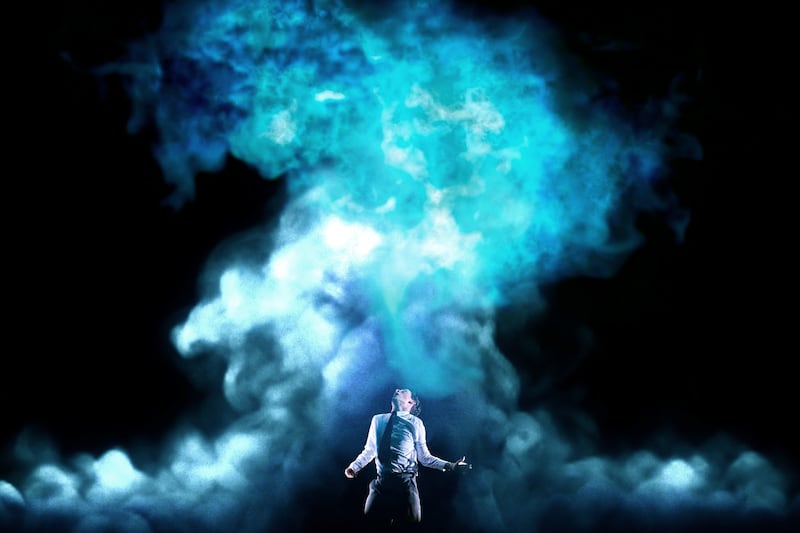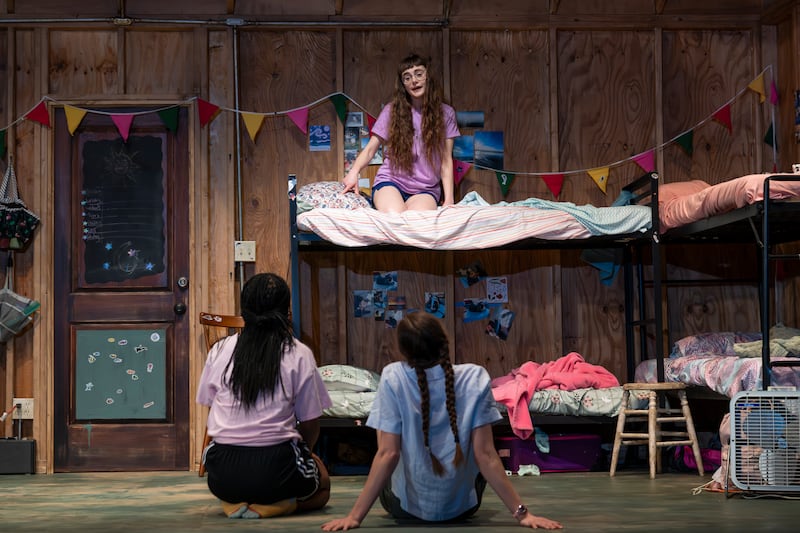“How did they do that?” you ask yourself over and over again, quite a bit thrilled and wowed—especially during the first act of Stranger Things: The First Shadow (Marquis Theatre, currently booking through Nov. 16). A prequel to the ’80s-set hit Netflix show, the stage show takes place in 1959 and is the origin story of Henry Creel (Louis McCartney), later to be known as Vecna.
While its makers insist you don’t need to be a watcher of the TV show to enjoy the Broadway show, it certainly helps—especially in the cavalcade of dramatic Easter eggs placed through the show by playwright Kate Trefry, a writer on the TV series who collaborated on the original story with Jack Thorne and the creators of the TV show, the Duffer Brothers.
Back in 1959 many of the parental figures in the show are young students themselves in Hawkins, Indiana, and so you see the beginnings of who they are, even down to replicating an earlier trio of teenage mystery solvers who set out to solve how and why animals are dying around town.

The Broadway show is a mash-up of genres: horror and monster movie, mystery of the week, shadowy government thriller, and teens-at-school comedy drama with bobby-socks (the pretty costuming is by Brigitte Reiffenstuel). At the beginning, we are on the roiling high seas in wartime, and a desperate situation which spirals out of control, the first immersion in the wonders of Miriam Beuther’s set, Jon Clark’s lighting, Paul Arditti’s sound, Jamie Harrison and Chris Fisher’s illusions and visual effects and 59’s video and visual effects.
The show is a proudly brazen piece of brand extension, with the familiar title card of the TV show opening the production, much to the delight of fans watching on. After the initial high-seas drama has abated, we meet the Creels, who are moving to town after some kind of terrible incident involving Henry and a schoolmate. He is clutching a radio that seems to be a gateway to whatever powers he possesses; a sound of crackling static flares into life whenever those powers express themselves, which is typically when he feels stressed or upset. Lightbulbs are particularly vulnerable to being blown to smithereens.

Director Stephen Daldry recreates all the jump scares and surprises of a TV show, yet within a piece of theater that revels in being just that.
Alongside the unfolding mystery of Henry’s identity and special powers (telekinesis, an infection of some kind of dark force), we watch the teenagers mount a school stage show. The delicacy and simplicity of the latter contrasts with the bells-and-whistles spectacle of the show’s bigger scenes, including inexplicable action events, figures in space-suits stalking the stage and aisles, and stark white clinical experimentation chambers suddenly becoming splattered with blood.
The show features gargantuan special effects and creepiness that segue-in-a-blink back to the simplicity of a school-room or domestic setting. We see characters levitate, double themselves, multiple spiders seemingly crawl over a stage, a gorily rendered, dead cat, bloodily murdered family members, and a towering, tentacled Mind Flayer. The appearance of the villainous Dr. Frenner (Alex Breaux), determined to torture the truth of Henry’s powers out of him, elicits a low roar of audience recognition.
McCartney delivers an excellent performance as Henry, both terrifying and vulnerable; his body a volcanically shaking vessel struggling to contain whatever has entered it. Who or what is he, he wants to know: a walking devil or just some scared, damaged kid? He is well-matched by the equally alienated and different Patty Newby (Gabrielle Neveah), who wants to save both him and herself.
As increasingly extreme chaos swirls around the duo, the more Scooby-Doo part of the show sees theater production director Joyce Maldonado (Alison Jaye), Jim Hopper (Burke Swanson) and Bob Newby (a great, quietly scene-stealing performance by Juan Carlos) in Henry and Patty’s wake, trying to solve all the strangeness erupting in town—their rudimentary tech devices with twinkling lights and trailing wires contrasting with the production’s own dazzling technology.

The second act, while impressive, feels more prosaic than the first—perhaps because the show has set its own bar so high. The mystery starts to feel repetitive and the story somewhat stuck, even if the mix of hi and lo-fi, grossout drama versus silly jokes, intense interrogations of identity versus dumb jocks and dance numbers keep the show on track.
A final, clever visual encourages you again to think of the stage show as an extension of the TV version—specifically its upcoming Season 5 which the Broadway show apparently links to directly. Watch where an on-screen cursor lands in the final seconds. This piece of theater wants ultimately to be seen, and appreciated, for what it is—not what you watch on a screen.
Grief Camp
Eliya Smith’s intriguing play, Grief Camp (Atlantic Theater, booking to May 11), focuses on a group of teenagers at a camp in the country, linked by their experiences of the deaths of loved ones.
Arjun Athalye, Grace Brennan, Jack DiFalco, Dominic Gross, Maaike Laanstra-Corn, Renée-Nicole Powell, Lark White, and Danny Wolohan deliver strong and natural performances as the young people—Alden Harris-McCoy is an occasionally sighted guitarist/adult figure—occasionally opening up to each other, occasionally snapping at each other, and mostly within their own worlds of grief and torment.

DiFalco and Powell get the most filled-out story as Cade and Olivia; he a slightly older camp counselor, she a hyper-sexual teen, deeply troubled after the loss of a sibling. Tony-nominated director Les Waters brings the same kind of insightful tenderness and heightened mystery he created so adeptly in Dana H. Louisa Thompson’s set of bunk beds is all-too-redolent of enforced enclosure.
The play might benefit from more direct and clear explanations about what has happened to some of the teens, but it is a sharply observed portrait of a time of life-altering pain and upheaval.
The post The ‘Stranger Things: The First Shadow’ Stage Effects Need to Be Seen to Be Believed appeared first on The Daily Beast.




